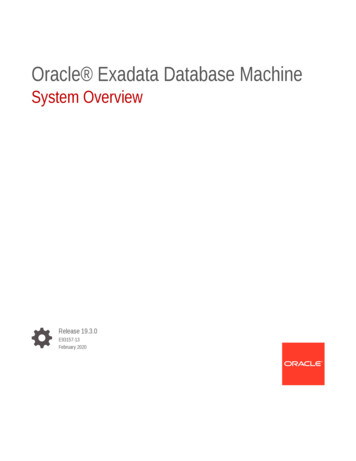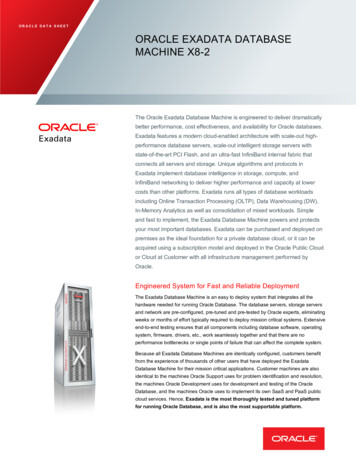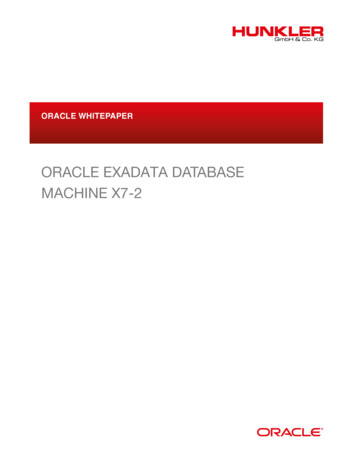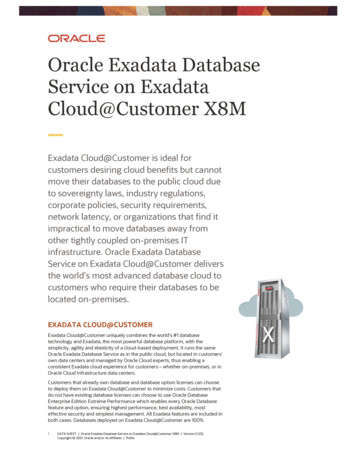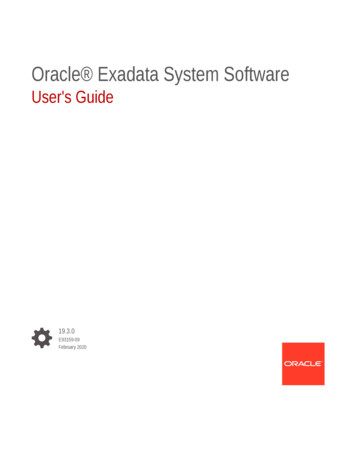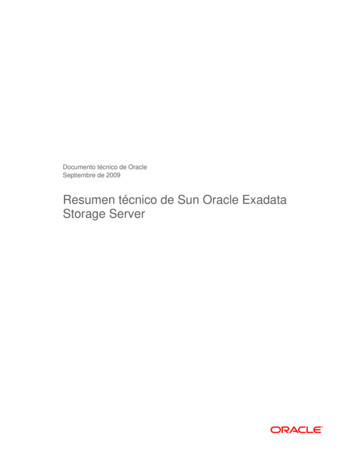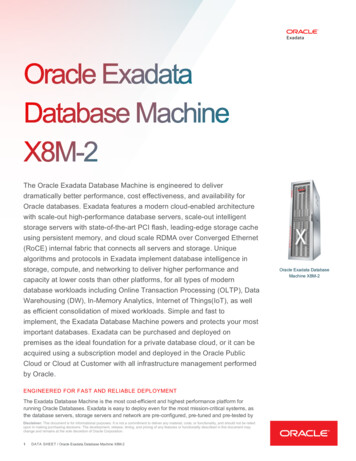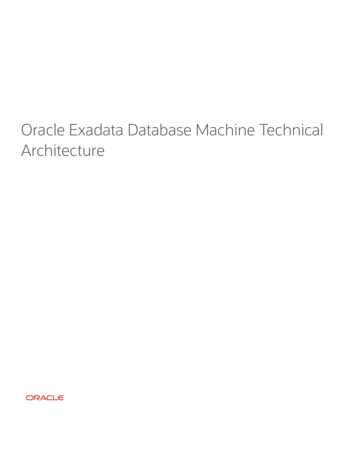
Transcription
Oracle Exadata Database Machine TechnicalArchitecture
Copyright 2022, Oracle and/or its affiliates. All rights reserved.This software and related documentation are provided under a license agreement containing restrictions on use and disclosure andare protected by intellectual property laws. Except as expressly permitted in your license agreement or allowed by law, you may notuse, copy, reproduce, translate, broadcast, modify, license, transmit, distribute, exhibit, perform, publish, or display any part, in anyform, or by any means. Reverse engineering, disassembly, or decompilation of this software, unless required by law forinteroperability, is prohibited.The information contained herein is subject to change without notice and is not warranted to be error-free. If you find any errors,please report them to us in writing.If this is software or related documentation that is delivered to the U.S. Government or anyone licensing it on behalf of the U.S.Government, then the following notice is applicable:U.S. GOVERNMENT END USERS: Oracle programs, including any operating system, integrated software, any programs installed onthe hardware, and/or documentation, delivered to U.S. Government end users are "commercial computer software" pursuant to theapplicable Federal Acquisition Regulation and agency-specific supplemental regulations. As such, use, duplication, disclosure,modification, and adaptation of the programs, including any operating system, integrated software, any programs installed on thehardware, and/or documentation, shall be subject to license terms and license restrictions applicable to the programs. No otherrights are granted to the U.S. Government.This software or hardware is developed for general use in a variety of information management applications. It is not developed orintended for use in any inherently dangerous applications, including applications that may create a risk of personal injury. If you usethis software or hardware in dangerous applications, then you shall be responsible to take all appropriate fail-safe, backup,redundancy, and other measures to ensure its safe use. Oracle Corporation and its affiliates disclaim any liability for any damagescaused by use of this software or hardware in dangerous applications.Oracle and Java are registered trademarks of Oracle and/or its affiliates. Other names may be trademarks of their respective owners.Intel and Intel Xeon are trademarks or registered trademarks of Intel Corporation. All SPARC trademarks are used under license andare trademarks or registered trademarks of SPARC International, Inc. AMD, Opteron, the AMD logo, and the AMD Opteron logo aretrademarks or registered trademarks of Advanced Micro Devices. UNIX is a registered trademark of The Open Group.This software or hardware and documentation may provide access to or information about content, products, and services from thirdparties. Oracle Corporation and its affiliates are not responsible for and expressly disclaim all warranties of any kind with respect tothird-party content, products, and services unless otherwise set forth in an applicable agreement between you and Oracle. OracleCorporation and its affiliates will not be responsible for any loss, costs, or damages incurred due to your access to or use of thirdparty content, products, or services, except as set forth in an applicable agreement between you and Oracle.Copyright 2022, Oracle and/or its affiliates2
Exadata Database Machine Rack OverviewOracle Exadata Database Machine features scale-out industry-standard database servers, scale-outintelligent storage servers, and high-speed internal RDMA Network Fabric that connects thedatabase and storage servers.You can select an eighth rack with 2 database servers and 3 storage servers or an elasticconfiguration with up to 22 total database and storage servers, including 2-19 database servers and3-18 storage servers.Copyright 2022, Oracle and/or its affiliates3
Exadata Database Machine also includes network switches to connect the database servers to thestorage servers, and you can add an optional spine switch to connect multiple racks.Note: All specifications are for Exadata X9M-2 racks. For details on all models, see ExadataDatabase Machine Hardware Components by Model.Copyright 2022, Oracle and/or its affiliates4
NetworkingOracle Exadata Database Machine includes equipment to connect the system to your network. Thenetwork connections allow clients to connect to the database servers and also enable remotesystem administration.Copyright 2022, Oracle and/or its affiliates5
The network has the following components: One Management switchOne database server, which represents all the database servers in the rackOne Exadata Storage Server, which represents all the storage servers in the rackTwo RDMA Network Fabric switchesTwo power distribution units (PDUs)Exadata Database Machine provides the following networks and interfaces: The administration network connects to the PDUs and the Management switch. Through theManagement switch, the administration network connects to dedicated administration andILOM ports on every database server and storage server, and also to each of the RDMANetwork Fabric switches.The client network is physically connected to every database server. The diagram shows apair of bonded physical connections. In a bonded network configuration, the client networkbonded interface name is BONDETH0.The private network, also known as the RDMA Network Fabric, interconnects all of thedatabase servers and storage servers using a pair of RDMA Network Fabric switches. On eachserver, one port is connected to each switch, which maximizes throughput and availability.Database servers can optionally connect to additional networks using the available openports that are not used by the administration network and the client network. The diagramshows a pair of bonded physical connections for an additional network. In a bonded networkconfiguration, the first additional network bonded interface name is BONDETH1, the secondadditional network bonded interface name is BONDETH2, and so on.For details on the networking requirements, see Understanding the Network Requirements forExadata Database Machine.Copyright 2022, Oracle and/or its affiliates6
Connecting Multiple RacksCopyright 2022, Oracle and/or its affiliates7
You can connect up to 12 RoCE-based Exadata racks together before external RDMA Network Fabricswitches are required.The diagram shows the RDMA Network Fabric architecture for two interconnected X9M racks. Eachrack shows two database servers (1 and n) and two storage servers (1 and m), which represent all thedatabase and storage servers in the rack.Each rack has one spine switch and two leaf switches. Each spine switch has seven connections toeach leaf switch. Leaf switch-to-leaf switch interconnection is not required. All database and storageservers connect to both leaf switches, the same as in a single rack.For details on connecting more than two Exadata X9M racks, see Multi-Rack Cabling Tables forOracle Exadata Rack X9M.Copyright 2022, Oracle and/or its affiliates8
Database ServersWhen deploying Oracle Exadata Database Machine, you can optionally implement virtual machines(VMs) on each database server. (Exadata Database Machine models with RDMA Network Fabric useOracle Linux KVM. Earlier models that use Infiniband Network Fabric use Oracle VM.)Each hypervisor can support multiple VM guests per database server. The number of VMs dependson the database server model and RDMA network technology. For details on VM guestspecifications, see Managing Oracle Linux KVM Guests or Managing Oracle VM User Domains.Copyright 2022, Oracle and/or its affiliates9
During configuration you install the Exadata system software, Oracle Database, and Oracle GridInfrastructure on each VM guest. For details on the database server software, see About DatabaseServer Software.The default user accounts include oracle, root, and grid (if you select role separation). For the full listof default users, see Default User Accounts for Oracle Exadata.External clients connect to the database servers through the client and additional networks withbonded network interfaces. RDMA Network Fabric interconnects all of the database servers andstorage servers using a pair of RDMA Network Fabric switches. On each server, one port isconnected to each switch. The RDMA Network Fabric ports use active bonding.Copyright 2022, Oracle and/or its affiliates10
Storage Server TypesWhen configuring Oracle Exadata Database Machine, you can choose High Capacity (HC) orExtreme Flash (EF) Storage Servers. You can also add Extended (XT) Storage Servers to store rarelyaccessed data that must be kept online.The storage server types have the following hardware components: HC Storage Servers include persistent memory (PMEM), flash, and hard disk drives (HDDs).EF Storage Servers have an all-flash configuration with PMEM.XT Storage Servers have HDDs only.Note: All specifications are for Exadata X9M-2 Storage Servers. For details on hardwarecomponents for all models, see Oracle Exadata Storage Server Hardware Components.Copyright 2022, Oracle and/or its affiliates11
High Capacity (HC) Storage ServersCopyright 2022, Oracle and/or its affiliates12
Each Oracle Exadata Storage Server High Capacity X9M-2 (HC) server includes the followinghardware components: Four 6.4 TB NVMe flash devices (PCIe)Twelve 18 TB hard disk drives (HDDs)Twelve 128 GB persistent memory (PMEM) modulesNote: All specifications are for Exadata X9M-2 Storage Servers (not including eighth rackconfigurations). For details on hardware components for all configurations and models, see OracleExadata Storage Server Hardware Components.RDMA Network Fabric interconnects all of the database and storage servers using a pair of RDMANetwork Fabric switches.Each storage server runs Oracle Exadata System Software to process data at the storage level andpass only what is needed to the database servers. For details on the software components, seeIntroducing Oracle Exadata System Software.On HC Storage Servers, you typically configure the flash as a flash cache (Exadata Smart FlashCache), which automatically caches frequently used data in high-performance flash memory. TheExadata Smart Flash Log also uses a small portion of flash memory as temporary storage to reducelatency for redo log writes. For details on Smart Flash, see Smart Flash Technology.Each storage server also includes a PMEM cache, also called the Persistent Memory DataAccelerator, in front of the flash cache to provide direct access to persistent memory throughRDMA. Additionally, PMEM contains recently written log records (not the entire redo log) in thePersistent Memory Commit Accelerator. For details on PMEM, see Persistent Memory Acceleratorand RDMA.You configure Oracle Automatic Storage Management (ASM) disk groups to store and manage yourdata across the HDDs on multiple HC Storage Servers to improve performance and provideredundancy to protect against disk failures. For details on ASM, see About Oracle AutomaticStorage Management.Copyright 2022, Oracle and/or its affiliates13
Extreme Flash (EF) Storage ServersCopyright 2022, Oracle and/or its affiliates14
Each Oracle Exadata Storage Server Extreme Flash X9M-2 (EF) server includes the followinghardware components: Eight 6.4 TB NVMe flash devices (PCIe)Twelve 128 GB persistent memory (PMEM) modulesNote: All specifications are for Exadata X9M-2 Storage Servers (not including eighth rackconfigurations). For details on hardware components for all configurations and models, see OracleExadata Storage Server Hardware Components.RDMA Network Fabric interconnects all of the database and storage servers using a pair of RDMANetwork Fabric switches.Each storage server runs Oracle Exadata System Software to process data at the storage level andpass only what is needed to the database servers. For details on the software components, seeIntroducing Oracle Exadata System Software.On EF Storage Servers, all of the data resides in flash so you don’t need the Exadata Smart FlashCache for normal caching. However, you still use the Exadata Smart Flash Cache to host thecolumnar cache, which caches data in columnar format and optimizes various analytical queries.The Exadata Smart Flash Log also uses a small portion of flash memory as temporary storage toreduce latency for redo log writes. For details on Smart Flash, see Smart Flash Technology.Each storage server also includes a PMEM cache, also called the Persistent Memory DataAccelerator, in front of the flash cache to provide direct access to persistent memory throughRDMA. Additionally, PMEM contains recently written log records (not the entire redo log) in thePersistent Memory Commit Accelerator. For details on PMEM, see Persistent Memory Acceleratorand RDMA.You configure Oracle Automatic Storage Management (ASM) disk groups to store and manage yourdata across the flash devices on multiple EF Storage Servers to improve performance and provideredundancy to protect against disk failures. For details on ASM, see About Oracle AutomaticStorage Management.Copyright 2022, Oracle and/or its affiliates15
Extended (XT) Storage ServersCopyright 2022, Oracle and/or its affiliates16
Each Oracle Exadata Storage Server Extended X9M-2 (XT) server includes twelve 18 TB hard diskdrives (HDDs). Unlike Extreme Flash (EF) and High Capacity (HC) storage servers, XT servers don’tcontain flash or persistent memory (PMEM).Note: All specifications are for Exadata X9M-2 Storage Servers (not including eighth rackconfigurations). For details on hardware components for all configurations and models, see OracleExadata Storage Server Hardware Components.You can add two or more XT Storage Servers to existing EC or HC Storage Servers to store rarelyaccessed data that must be kept online. (The diagram shows two XT Storage Servers in addition tothree EF Storage Servers.)RDMA Network Fabric interconnects all of the database and storage servers using a pair of RDMANetwork Fabric switches.Each XT Storage Server runs the same Oracle Exadata System Software as HC and EF StorageServers. XT Storage Servers do not require licenses for Exadata System Software and include HybridColumnar Compression. If you enable SQL Offload features on XT Storage Servers, Exadata SystemSoftware licenses are required. For details on the software components, see Introducing OracleExadata System Software.You configure Oracle Automatic Storage Management (ASM) disk groups to store and manage yourdata across the HDDs on multiple XT Storage Servers to improve performance and provideredundancy to protect against disk failures. You set up different disk groups for XT, HC, and EFStorage Servers. For details on ASM, see About Oracle Automatic Storage Management.Copyright 2022, Oracle and/or its affiliates17
Exadata System SoftwareOracle Exadata System Software provides database-aware storage services, such as the ability tooffload SQL and other database processing from the database server. The database and storageservers both contain components of the Exadata System Software.Each database server includes the following software components: Oracle Database instance, including the Oracle Database Resource Manager (DBRM) formanaging resource allocationExadata System Software, including the DBMCLI command-line interface for managing theExadata System Software on the database serversCopyright 2022, Oracle and/or its affiliates18
Management Server (MS), which works in cooperation with and processes most of thecommands from the DBMCLIOracle Grid Infrastructure, including Oracle Automatic Storage Management (ASM), which isthe cluster volume manager and file system used to manage the data stored on the storageserversEach storage server includes data storage hardware (disks or flash) and Exadata System Software tomanage the data. The software includes the following components: Cell Control Command-Line Interface (CellCLI) for managing the Exadata System Software onthe storage serversCell Server (CELLSRV), which provides the majority of the storage server services, includingthe advanced SQL offload capabilities and the I/O Resource Management (IORM)functionality to meter out I/O bandwidth to the various databases and consumer groupsissuing I/O callsMS, which works in cooperation with and processes most of the commands from the CellCLIRestart Server (RS), which monitors the heartbeat with the MS and the CELLSRV processesand restarts the servers if they fail to respond within the allowable heartbeat periodRDMA Network Fabric interconnects all of the database and storage servers using a pair of RDMANetwork Fabric switches.Administrators manage the database and storage servers through Secure Shell (SSH) or local accessover the admin network (not shown in the diagram). Administrators can use the followingcommand-line interfaces: DBMCLI for managing the database serversCellCLI for managing the storage serversdcli for automating operating system commands on a set of database or storage serversExaCLI for managing database and storage servers remotelyexadcli for centrally managing an Oracle Exadata system by automating ExaCLI commandsNote: This slide lists the most relevant Exadata System Software components. For the full list ofcomponents, see Oracle Exadata System Software Components.Copyright 2022, Oracle and/or its affiliates19
Data StorageOracle Exadata Storage Servers include physical disks, which can be hard disk drives (HDDs) or flashdevices. Each physical disk has a logical address, called a logical unit number (LUN), which makes itavailable to the operation system (OS) and contains an OS storage area.The cell disk is a higher level of abstraction that represents the data storage area on each LUN. Youcan divide a cell disk into multiple grid disks, which are directly available to Oracle AutomaticStorage Management (Oracle ASM). For example, the diagram shows a cell disk divided into twogrid disks. The cell disk also contains a segment called the cell system area, which is used by theOracle Exadata System Software.Copyright 2022, Oracle and/or its affiliates20
This level of virtualization enables multiple Oracle ASM clusters and multiple databases to share thesame physical disk.For details on the storage entities and relationships, see About Oracle Exadata System Software.Copyright 2022, Oracle and/or its affiliates21
Oracle ASM Grid Disks and Disk GroupsOracle Exadata Database Machine uses Oracle Automatic Storage Management (Oracle ASM) as thecluster volume manager and file system to manage data storage.When configuring your Exadata rack, you define one or more Oracle Grid Infrastructure (GI) clusters,and you assign database and storage servers to the cluster. For example, the diagram shows one GIcluster with two database servers and three storage servers.RDMA Network Fabric interconnects all of the database and storage servers using a pair of RDMANetwork Fabric switches.Each storage server includes physical disks, which can be hard disk drives (HDD) or flash devices.One physical disk corresponds to one cell disk. You divide the cell disks into multiple grid disks. (Forsimplicity, the diagram shows only three cell disks per storage server and three differently sized griddisks per cell disks.)Copyright 2022, Oracle and/or its affiliates22
Your assign grid disks to ASM disk groups, which span cell disks across storage servers to improveperformance and provide redundancy to protect against disk failures.You typically configure the following Oracle ASM disk groups: DATA is the primary data disk group.RECO is the primary recovery disk group, which contains the Oracle Database Fast RecoveryArea (FRA).SPARSE is an optional sparse disk group that supports Exadata snapshots.XTND is the default name for the disk group for Extended (XT) Storage Servers (not shown inthe diagram).You also configure the redundancy level for each disk group: HIGH redundancy (recommended) requires at least three storage servers and maintainsthree copies of every data block. (The diagram shows HIGH redundancy.)NORMAL redundancy requires at least two storage servers and maintains two copies of everydata block.For details on ASM disk groups, see About Oracle Automatic Storage Management.Copyright 2022, Oracle and/or its affiliates23
For details on hardware components for all configurations and models, see Oracle Exadata Storage Server Hardware Components. RDMA Network Fabric interconnects all of the database and storage servers using a pair of RDMA Network Fabric switches. Each storage server runs Oracle Exadata System Software to process data at the storage level and
